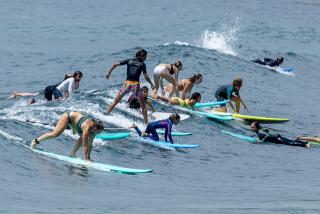Surfing for Novices Begins in the Home
- Share via
You can start learning to surf in your living room. The maneuver you need to master is standing up. You should practice time after time so that when you do catch that first wave, you’ll be ready to spring into action.
You don’t even need a board for this part. Lie down on your stomach in a push-up position. As you push yourself up, quickly bring both feet underneath you, one foot in front of the other, pointing to the side. You should be in a crouched position.
Do not go to your knees first, or stand up one leg at a time, as this will slow your progress as your surfing improves. Also, it’s generally easier to stand up without being impeded by a surf leash when you are learning.
If you look at your feet, you will see that you have already begun to forge your new identity as a surfer--when you jump to your feet, one foot will go naturally in front of the other. If your left foot is forward, you are a regular-foot, if your right foot is in front, you’re a goofy-foot.
Of course, standing up on your surfboard will be a little more difficult than surfing on your living room carpet, but the principle is the same.
Next, try to get started with the right board.
Although the modern 6-foot, tri-fin boards that are used today are light and extremely maneuverable, they are rather unstable for a beginner. Try to use a 7- or 8-foot board, or a longboard, which is 9 or 10 feet long. Softboards, which are surfboards made of spongy, Boogie board type material, are highly recommended for beginners since they don’t hurt when you get hit by them.
A fiberglass board, hurled at you with the power of the sea, can be a dangerous weapon. Just remember not to put your head or any other part of your body between the board and the shore when a wave or white water (the broken wave, or soup) is approaching.
For your first ride, find a gradually sloping sandy beach, and stay clear of piers, jetties, rocks and exposed reefs. Go with an experienced surfer and stay away from crowds, but in the vicinity of a lifeguard.
Before you can catch a wave and ride it all the way in, you must first paddle the board out into the surf--which can be more difficult than it looks. Sometimes it’s hard just to lie down on the board without it squirting out from under you.
Lay the board next to you in about thigh-deep water. Lie on the board with your head toward the nose of the board, with your weight distributed evenly. Center yourself longways on the board--don’t get so far forward that the nose sinks underwater, and don’t get so far back that the nose sticks up into the air.
Once you get the surfboard in position, start paddling out, one arm after the other, like a swimming stroke. Always keep your head up and your eyes open.
You want to catch the white water rather than the blue face of the wave.
When you see the white water coming to you, point the nose of your board toward shore and begin paddling smoothly. If you can, have someone give you a little push as the wave comes.
As soon as you feel the wave has you in its power, and it’s pushing you toward shore, place your hands firmly on the side of the board, right beneath your armpits, and spring carefully to your feet, just as you practiced.
Repeat.
Before long, you’ll understand what the Beach Boys meant when they sang, “Catch a wave and you’re sittin’ on top of the world.”


